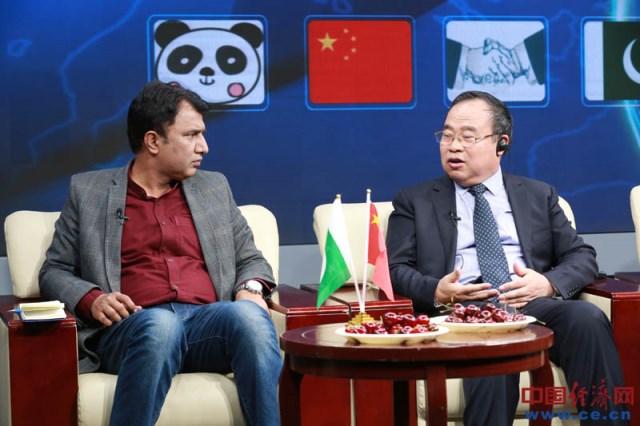Pakistani cherries rival Chilean counterparts, yet hard to enter Chinese market
Officials discuss hurdles and other issues facing the fruit’s export to China

PHOTO: REUTERS
These were the views shared by the Chinese and Pakistani guests in a recent interview with economic daily China Economic Net for the special programme ‘Cherries and FTA’.
Against the backdrop of Pakistan reopening its airspace and China holding its annual two sessions, six Chinese and Pakistani guests, including Zhao Jinping, former director-general of the Research Department of Foreign Economic Relations, Development Research Centre of the State Council, and Dunya TV Chief Editor Akram Habib turned the interview into a witty discussion.
Nearly the same time a year ago, Pakistan’s Ambassador to China Masood Khalid mentioned Pakistan’s cherry during his exclusive interview with the China Economic Net.

Pakistan has one of the world’s best cherries
“As a Pakistani, I can honestly say that we have one of the world’s best cherries. They are very juicy,” said Habib.
Speaking on the subject, an official at the Embassy of Pakistan in China, Hina Firdous, said, “The size of Pakistan’s cherry is very big.”
“What Chinese people know is that Pakistan’s mango is famous, but they have no idea that Pakistan has such great cherry,” said Zhou Rong, senior researcher at Chongyang Institute for Financial Studies of Renmin University of China. Balochistan borders Afghanistan and Iran, and on the south-western coast of the province is Gwadar Port, which China helps to build the free trade area. Although it is quite hard for cherry tree to survive, Balochistan is suited for planting this fruit. “Cherry prices are very high in the Chinese market. If the Chinese government decides to import cherry from a certain country, it will encourage local farmers to increase planting. As the quantity of cherry available in the market grows, the import price could fall,” The Express Tribune Editor Naveed Hussain said in the interview.
Pakistani cherry has no seasonal advantages
A report by the United States Department of Agriculture on the ‘Output of Fresh Cherry by Major Producing Countries’ does not include Pakistan. Chile is expected to break the record of 190,000 tons in the season of 2018-19 due to increasing demand from China.
Argentina, which is not on the list of major producing countries, reached a quarantine agreement with China’s General Administration of Customs at the end of last year, and the first batch of cherry exported to China set off in January. Then, why the cherries from the three countries mentioned above have different fates?
Elaborating further, Hussain said that though Pakistan is competitive in cherry taste, the main reason China imports cherries from New Zealand, Chile and Argentina is the seasonal difference due to geographic locations – southern and northern hemisphere - and Pakistan has almost the same harvest season as China.
“We imported cherry from eight countries, including Chile, the US, Australia, New Zealand, Canada, Tajikistan and Turkey. Since no significant difference exists between the two countries, it can be difficult for Pakistani cherry to be exported to China,” Zhou added.
White cherry of Balochistan not available in Karachi
“Pakistan’s advertising is not as good as Chile’s. We can find Chile’s advertisement in second and third-tier cities in China; as Pakistan is quite near to us, you have enough edge in advertising,” Zhou said.
“I knew nothing about Balochistan’s cherry over the past 10 years, when I worked in Pakistan, therefore, the effort for information exchange is insufficient and we should strengthen market research.”
Reiterating the sentiment, The Express Tribune editor added, “Just as Zhou said, even Pakistanis themselves lack knowledge about cherries, hence it has been marginalised. Pakistan has an annual cherry output of 4,000 tons, but we do not put much emphasis on the systematic collection of information about the high-end fruit.”
China Overseas Ports Holding Company Pakistan Chairman Zhang Baozhong commented, “I went to Quetta, the capital of Balochistan, in the harvest season. We were free to take cherries from a cherry orchard next to our hotel. Pakistan’s cherry is indeed the best, with its main producing areas located in the north. Balochistan is also rich in agricultural products.”
Highlighting the problems in cherry transportation, Global Care Managing Director Amanullah Khan said, “Balochistan’s main product, white cherries, is rarely shipped to Karachi because of its poor infrastructure. We export a lot of mangoes and we have the infrastructure to export mangoes, but the transportation of peaches, apricots and cherries, which you’ve just introduced, planting and growing in different regions, requires increased investment in infrastructure, with packaging and other links included.”
Expedite cherry’s ‘zero tariff’ process
After discussing the seasonality, information exchange and transportation of Pakistani cherries, Zhao Jinping stressed that there is a very important factor, that is, the tariffs between China and Pakistan.
He said the first phase of the China-Pakistan free trade agreement (FTA) was signed on November 24, 2006 and the two sides implemented tariff reduction on about 6,000 items. Some of them were reduced to zero tariffs after a five-year transition period and the liberalisation rate, which means the coverage ratio of zero tariff goods in varieties and quantities, would be lifted to 85% over a period of about 10 years.
He was of the view that the 85% coverage ratio is not high in the international market, “according to the current information disclosed by the two countries, if it can be raised to more than 90% in the second stage of the free trade negotiations, many commodities similar to cherries will be covered, which will lead to a decrease in the cost and price of Pakistani goods exported to China, and an enhanced market share and competitiveness in China.
“As we talked about Chilean cherries, the ratio between China and Chile has reached 98% and almost all goods can enter China without tariff, which has a positive effect on lowering the price of Chilean cherries.”
Statistics from China’s General Administration of Customs suggest the volume of total import and export between China and Pakistan was $19.08 billion in 2018, of which Pakistan’s exports to China totalled $2.18 billion, accounting for slightly more than 10%. Just a week before the programme, Pakistan’s ambassador to China had said in an informal discussion organised by the embassy that the tension between India and Pakistan would not have any impact on economic exchanges between China and Pakistan.
“I hope that we can eat Pakistani cherries in China one day,” he said.
This article originally appeared on the China Economic Net
Published in The Express Tribune, March 25th, 2019.
Like Business on Facebook, follow @TribuneBiz on Twitter to stay informed and join in the conversation.



















COMMENTS
Comments are moderated and generally will be posted if they are on-topic and not abusive.
For more information, please see our Comments FAQ